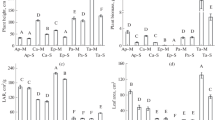Summary
The response of net photosynthesis and dark respiration in eight species of Umbilicariaceae (lichenes) to temperature (-5, 0, 5, 10, 15, 20, 25, 30°C) and irradiance (55, 110, 220, 400, 620 μmol photons m-2 s-1 PAR) was studied. The samples were collected in montane and alpine localities of the Spanish Sistema Central. The species differed widely in their net photosynthetic rates. The optimal temperature for net photosynthesis in alpine species was significantly lower than in montane species. Montane species were more photophytic than alpine ones. Water saturation and water loss rate were dependent on morphology and particularly anatomy of the thallus. The physiological and structural data are useful in the interpretation of the ecology and altitudinal distribution of the Umbilicariaceae. No adaptation could be linked to particularities of the mediterranean climate.
Similar content being viewed by others
References
Bachmann E (1923) Untersuchungen über den Wasserhaushalt einiger Felsenflechten. Jahrb Wiss Botanik 62:20–64
Bailey C, Larson DW (1982) Water quality and pH effects on Umbilicaria mammulata (Ach.) Tuck. Bryologist 85:431–437
Brown DH (1980) Notes on the instavility of extracted chlorophyll and a reported effect on ozone on lichen algae. Lichenologist 12:151–154
Harris GP (1971) The ecology of corticolous lichens II. The relationship between physiology and environment. J Ecol 59:441–452
Harris GP (1972) The ecology of corticolous lichens III. A simulation model of productivity as a function of light intensity and water availability. J Ecol 60:19–40
Harrison PM, Walton DWH, Rothery P (1986) The effect of temperature and moisture on dark respiration in the foliose lichen Umbilicaria antartica. New Phytol 103:443–455
Kallio P, Kärenlampi L (1975) Photosynthesis in mosses and lichens. In: Cooper JP (ed) Photosynthesis and Productivity in Different Environments. Int Biol Progr 3:393–423
Kappen L (1974) Response to extreme environments. In: Ahmadjian V, Hale ME (eds) The Lichens. Academic Press Inc., New York, pp 311–380
Kappen L (1983) Ecology and physiology of the Antarctic fructicose lichen Usnea sulphurea (König) Th. Fries. Pol Biol 1:249–255
Kappen L (1988) Ecophysiological relationships in different climatic regions. In: Galun M (ed) Handbook of Lichenology II, Chapter VII B2. CRC Press Inc., Boca Raton Florida, pp 37–100
Kappen L, Redon J (1987) Photosynthesis and water relations of three maritime Antarctic lichen species. Flora 179:215–229
Kappen L, Bölter M, Kühn A (1987) Field measurements of net photosynthesis of lichens in the Antarctic. Polar Biol 5:255–258
Kershaw KA (1975) Studies on lichen-dominated systems XII. The ecological significance of thallus color. Can J Bot 53:660–667
Lange OL (1954) Einige Messungen zum Wärmehaushalt poikilohydrer Flechten und Moose. Arch Meteorol, Geophysik Bioklimatol Ser B: Allg Biol Klimatol 5:182–190
Lange OL (1965) Der CO2-Gaswechsel von Flechten bei tiefen Temperaturen. Planta 64:1–19
Lange OL (1969) Experimentell-ökologische Untersuchungen an Flechten in der Negev-Wüste I. CO2-Gaswechsel von Ramalina maciformis (Del.) Bory unter kontrollierten Bedingungen im Laboratorium. Flora Abt B 158:324–359
Lange OL (1980) Moisture content and CO2 exchange of lichens I. Influence of temperature on moisture dependent net photosynthesis and dark respiration in Ramalina maciformis. Oecologia 45:82–87
Lange OL, Kappen L (1972) Photosynthesis of lichens from Antarctia. In: Llano GA (ed) Antarctic Terrestric Biology Antarctic Res Ser Am Geophys Union 20:83–95
Pange OL, Kilian E (1985) Reaktivierung der Photosynthese trokkener Flechten durch Wasserdampfaufnahme aus dem Luftraum: Artspezifisch unterschiedliches Verhalten. Flora 176:7–23
Lange OL, Koch W, Schulze E-D (1973) Ecophysiological investigations on lichens of the Negev Desert II. CO2 gas exchange and water conservation of Ramalina maciformis (Del.) Bory in its natural habitat during the summer dry period. Flora 159:38–62
Lange OL, Kilian E, Meyer A, Tenhunen JD (1984) Measurement of lichen photosynthesis in the field with a portable steady-state CO2-Porometer. Lichenologist 16:1–9
Larson DW (1979) Preliminary studies of the physiological ecology of Umbilicaria lichens. Can J Bot 57:1398–1406
Larson DW (1980) Seasonal change in pattern of net CO2 exchange in Umbilicaria lichens. New Phytol 84:349–369
Larson DW (1981) Differential wetting in some lichens and mosses: The role of morphology. Bryologist 84:1–15
Larson DW (1982) Environmental stress in Umbilicaria lichens: The effects of subzero temperature pretreatments. Oecologia 55:268–278
Larson DW (1983) The pattern of production within individual Umbilicaria lichen thalli. New Phytol 94:409–419
Larson DW, Carey CK (1986) Phenotypic variation within “individual” lichen thalli. Am J Bot 73:214–223
Larson DW, Kershaw KA (1976) Studies on lichen-dominated systems XVIII. Morphological control of evaporation in lichens. Can J Bot 54:2061–2073
Matthes U (1980) Photosynthetischer CO2 Gaswechsel verschiedener Flechtenarten in Abhängigkeit vom Wassergehalt des Thallus. Diplomarbeit Würzburg 1980
Ried A (1960) Thallusbau und Assimilationshaushalt von Laubund Krustenflechten. Biol Zentralbl 79:129–151
Rivas-Martínez S (1988) Memoria del Mapa de Series de Vegetación de Espa na 1:400 000. Madrid. ICONA
Rundel PW (1982) The role of morphology in the water relations of desert lichens. Proceedings of the Symposia on Lichenology at the XIII International Congress, Sydney 1981, Part 2. J Hattori Bot Lab 53:305–307
Sancho LG (1986) Flora y vegetación liquénica saxícola de los pisos oro- y crioromediterráneo del Sistema Central español. Universidad Complutense de Madrid. Fac. de Biología
Sancho LG, Balaguer L (1989) Estudio comparado de la anatomía del talo en el género Lasallia Mérat (Umbilicariaceae, lichenes). Anales Jard Bot Madrid (in press)
Sancho LG, Crespo A (1989) Lasallia hispanica (Frey) comb. nov. and related species. Lichenologist 21:45–58
Sonesson M (1986) Photosynthesis in lichen populations from different altitudes in Swedish Lapland. Polar Biol 5:113–124
Türk R (1981) Laboruntersuchungen über den CO2-Gaswechsel von Flechten aus den mittleren Ostalpen. Phyton 23:1–18
Author information
Authors and Affiliations
Rights and permissions
About this article
Cite this article
Sancho, L.G., Kappen, L. Photosynthesis and water relations and the role of anatomy in Umbilicariaceae (lichenes) from Central Spain. Oecologia 81, 473–480 (1989). https://doi.org/10.1007/BF00378954
Received:
Accepted:
Issue Date:
DOI: https://doi.org/10.1007/BF00378954




